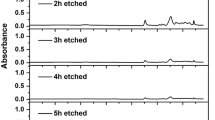Abstract
In the present work we have employed allyl diglycol carbonate (CR-39) and cellulose triacetate (CTA) plastic for detection of neutron recoil tracks without radiator. For CR-39, the results reveal that registration efficiency is a function of duration of chemical pre-etching and the best results are obtained with chemical pre-etching of 3 hours. It was also investigated that the ac field strength of 28 kV/cm having 2.5 kHz frequency was optimum for revelation of tracks. Interestingly the sensitivity is fluence dependent and it was constant up to a fluence of about 108 n/cm2. The sensitivity abruptly decreased with increased fluence. At optimum experimental conditions the minimum detection limit for CR-39 was found to be 0.47 mSv. For CTA, the tracks have been revealed by electrochemical etching (ECE) only and the minimum detection limit was found to be 0.85 mSv at optimum experimental parameters.
Similar content being viewed by others
References
M Sohrabi and K Becker Nucl. Instr. Meth. 104 409 (1972)
M Sohrabi Hlth. Phys. 27 598 (1974)
K Turek and G Somogyi Proc. Int. Conf. on New Methods of Personnel Dosimetry(Czechoslovakia: Hradec Kralove) p274 (1977)
G Somogyi, G Dajko, K Turek and F Spumy Nucl. Tracks 3 125 (1979)
M Sohrabi Nucl. Tracks 4 131 (1981)
A G Ramli and S A Durrani Proc. XI Int. Conf. on SSNTD (UK: Bristol) p237 (1981)
G M Haasib, J W M Tuyn and J Dutrannois Nucl. Instr. Meth. 14 163 (1977)
Ravi Chand Singh and H S Virk Nucl. Tracks Radiat. Meas. 15 301 (1988)
Ravi Chand Singh and H S Virk Nucl. Instr. Meth. B30 598 (1987)
S A R Al-Najjar and S A Durrani Nucl. Tracks Radiat. Meas. 8 99 (1979)
K Turek and G Dajko Nucl. Tracks Radiat. Meas. 8 121 (1984)
J W Thomas USAEC Health and Safety Report, HASL-TM-71-1 (1971)
A M Bhagwat PhD Thesis (Health Physics Division, BARC, Bombay, India) (1983)
H Kiefer and R Maushart Radiation Protection Measurement (Oxford: Pergamon Press) (1972)
Author information
Authors and Affiliations
Corresponding author
Rights and permissions
About this article
Cite this article
Singh, R.C., Singh, M. & Virk, H.S. Electrochemical etching technique for neutron dosimetry. Indian J Phys 83, 827–832 (2009). https://doi.org/10.1007/s12648-009-0035-x
Published:
Issue Date:
DOI: https://doi.org/10.1007/s12648-009-0035-x




